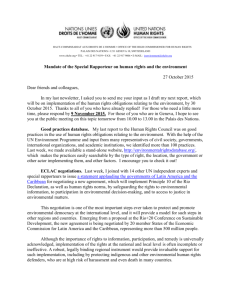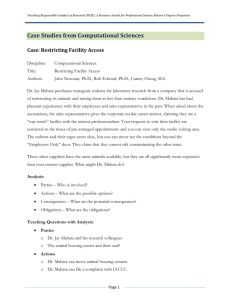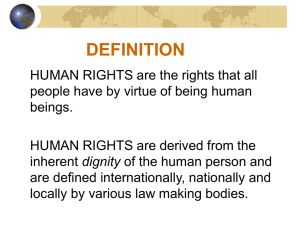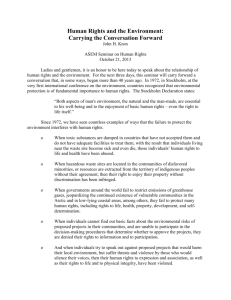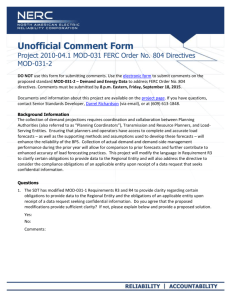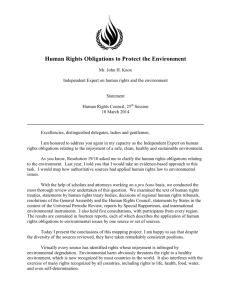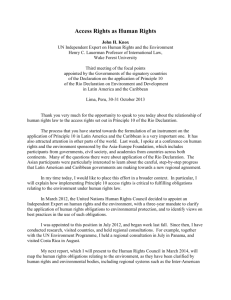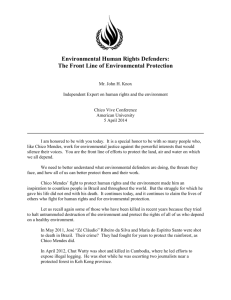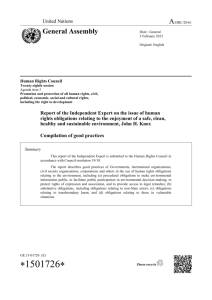here - United Nations Mandate on Human Rights and the Environment
advertisement
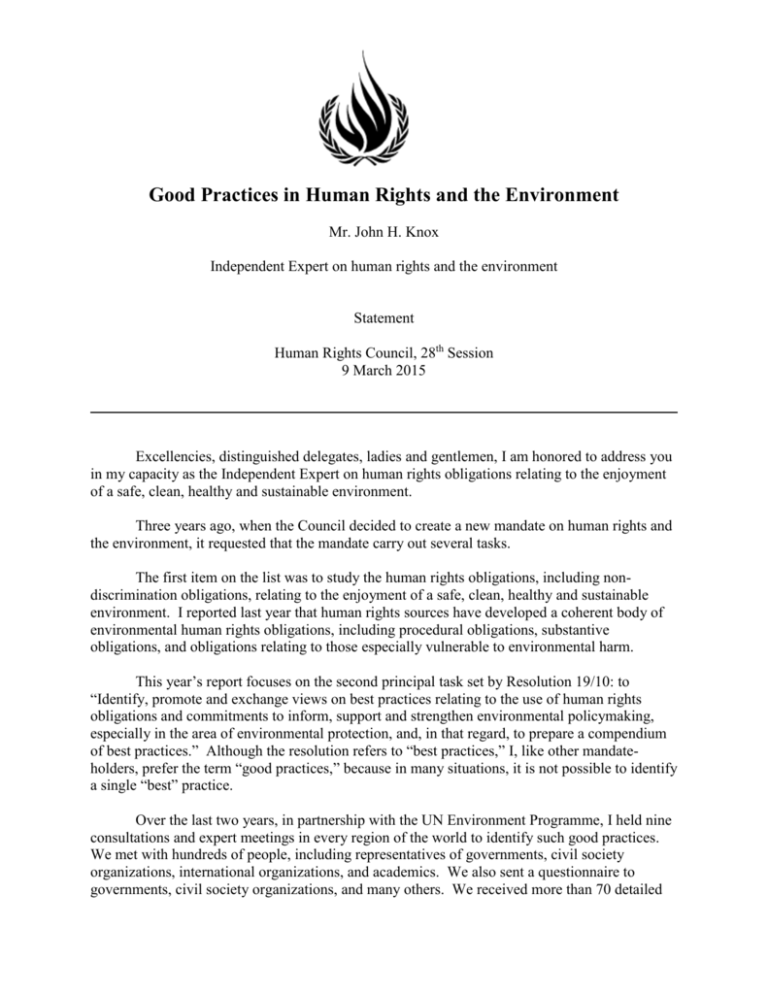
Good Practices in Human Rights and the Environment Mr. John H. Knox Independent Expert on human rights and the environment Statement Human Rights Council, 28th Session 9 March 2015 Excellencies, distinguished delegates, ladies and gentlemen, I am honored to address you in my capacity as the Independent Expert on human rights obligations relating to the enjoyment of a safe, clean, healthy and sustainable environment. Three years ago, when the Council decided to create a new mandate on human rights and the environment, it requested that the mandate carry out several tasks. The first item on the list was to study the human rights obligations, including nondiscrimination obligations, relating to the enjoyment of a safe, clean, healthy and sustainable environment. I reported last year that human rights sources have developed a coherent body of environmental human rights obligations, including procedural obligations, substantive obligations, and obligations relating to those especially vulnerable to environmental harm. This year’s report focuses on the second principal task set by Resolution 19/10: to “Identify, promote and exchange views on best practices relating to the use of human rights obligations and commitments to inform, support and strengthen environmental policymaking, especially in the area of environmental protection, and, in that regard, to prepare a compendium of best practices.” Although the resolution refers to “best practices,” I, like other mandateholders, prefer the term “good practices,” because in many situations, it is not possible to identify a single “best” practice. Over the last two years, in partnership with the UN Environment Programme, I held nine consultations and expert meetings in every region of the world to identify such good practices. We met with hundreds of people, including representatives of governments, civil society organizations, international organizations, and academics. We also sent a questionnaire to governments, civil society organizations, and many others. We received more than 70 detailed responses, including from many of the governments represented here, for which I thank you. And I undertook two country visits, to Costa Rica in 2013 and to France in 2014, each of which resulted in the identification of more good practices. As a result of these and other contacts, we have identified more than 100 good practices, which are briefly summarized in the report. We have also posted on the UN website a one-page description of each practice and links to further information about it. I have also developed a standalone website that should make the practices easier to search online. My limited time with you today does not permit me to describe all of the practices in detail. Instead, I will try to give you some illustrative examples. I apologize in advance for those that I have to leave out. The report organizes the good practices according to the three main categories of human rights obligations, beginning with procedural obligations. The main procedural obligations identified by human rights bodies are: (a) to make environmental information public; (b) to facilitate public participation in environmental decision-making; and (c) to provide access to effective remedies for environmental harm. These obligations are also supported by international environmental instruments, especially Principle 10 of the Rio Declaration. Some good practices promote all three of these obligations. For example, in 2010, the UNEP Governing Council adopted the Bali Guidelines for the Development of National Legislation on Access to Information, Public Participation and Access to Justice in Environmental Matters. Later this year, UNEP will publish a comprehensive guide for the implementation of the Bali Guidelines. Regional bodies are also taking concrete steps to support these access rights. European and central Asian States belong to the Aarhus Convention, which sets out detailed requirements in respect of these rights, and the Organization for Security and Co-operation in Europe supports a network of Aarhus Centres that provide education and training about the Aarhus rights. Nineteen States in Latin America and the Caribbean, with the assistance of the UN Economic Commission for Latin America and the Caribbean, decided in November 2014 to begin negotiation of a new regional agreement that would implement the access rights set out in Principle 10, with a view to completing the negotiation by December 2016. Together with the Aarhus Convention, this initiative will provide invaluable models to other regions considering similar agreements. Civil society organizations have also engaged in exemplary practices. For example, the Access Initiative, a global network of more than 150 organizations, is working with the World Resources Institute to develop an Environmental Democracy Index, which measures countryspecific realization of the three procedural rights according to indicators based on the Bali Guidelines. This proposal will be described at a side event at 4.30 today, in room 21. Many good practices build on particular rights. For example, with respect to the right to environmental information, El Salvador has adopted an innovative way of obtaining information: its Environmental Observatory monitors potential environmental threats based on 2 reports by a network of local observers. States have also emphasized environmental education and awareness-raising. For example, Algeria has designed environmental educational tools for different levels of schools, and has trained teachers in their use. Costa Rica has a Certificate of Sustainable Tourism programme that assigns companies in the tourism industry a “sustainability” rating. Ghana assesses the performance of mining and manufacturing operations through a five-colour rating scheme designed to be easy to understand and use. With respect to public participation in environmental decision-making, a large number of States have adopted exemplary statutes providing for such participation. Some States have even included such requirements at the constitutional level. A notable example is France, which adopted an Environmental Charter in 2004. One of its ten principles states that “each person has the right . . . to participate in the public decision-making process likely to affect the environment.” Even before the Charter, France was a leader in facilitating public discussion of large initiatives and projects. Its National Commission for Public Debate organizes public debates early in the process of considering major development projects, such as the construction of nuclear reactors, railways, and radioactive waste storage facilities. Everyone I met praised the Commission. Their only criticism was that similarly effective processes are not always applied to smaller projects. Such projects may be open to public participation late in the process, perhaps too late to assure those affected that the participation is meaningful. Other countries also provide examples of good practices in including a wide range of stakeholders in environmental decision-making. In Mexico, the government has established regional and national consultative councils for sustainable development that include representatives of civil society organizations, academia, the corporate sector and government agencies. In Mongolia, the Asia Foundation has worked with government agencies, citizens and corporations to create Local Multi-Stakeholder Councils composed of representatives of mining companies, local governments and communities. It is also important to build local capacity to take advantage of the opportunities that exist. Namati, a non-profit organization, has trained “community paralegals” to empower individuals and communities to protect their lands and national resources. As I reported last year, the rights of freedom of expression and association are of special importance for public participation in environmental decision-making. States have obligations not to violate these rights directly, and also to protect the life, liberty and security of individuals exercising their rights. States need to do more to protect environmental advocates from harassment, interference and even death. In 2014, Global Witness reported that between the beginning of 2002 and the end of 2013, 908 people in 35 countries were killed because of their work defending environmental and land rights. Even worse, the danger appears to be increasing; Global Witness reported that three times as many defenders were killed in 2012 as in 2002. Civil society organizations gave us many good practices, including providing emergency protection to environmental human rights defenders in the field, assisting threatened defenders with relocation support and medical care, training defenders to recognize and respond to threats, 3 and otherwise giving them legal and scientific support. It is disappointing that we did not receive similar proposals from governments. I urge all States to recognize that the risks environmental defenders face are a global problem, and to show the same kind of innovative thinking to this challenge that they bring to other areas of environmental and human rights policy. On a happier note, States have adopted a wide range of good practices in the provision of access to effective remedies for environmental harm, including by: establishing dedicated environmental tribunals, such as the Indian system of Green Tribunals, which have wide jurisdiction to hear environmental claims; facilitating access of environmental plaintiffs to courts of general jurisdiction, such as through the procedural rules adopted by the Philippine Supreme Court; building judicial expertise and contacts, as the Asian Judges Network on Environment has done; and giving public prosecutors and ombudspersons jurisdiction to investigate environmental abuses, as they can in Brazil, Costa Rica, Croatia, Hungary, and Portugal. Finally, a particularly good practice in relation to effective remedies is for national human rights commissions to investigate environmentally related abuses of rights, as they have in Kenya, Malaysia, Mexico, and Thailand. In addition to the procedural obligations described above, States have substantive obligations to adopt and implement legal frameworks to protect against environmental harm that may interfere with the enjoyment of human rights, including by protecting against such harm arising from the actions of corporations and other non-State actors. In an important sense, all environmental laws that set stringent environmental standards are good practices in the protection of the many human rights that depend on a healthy environment. However, the report focuses on practices that link strong environmental standards more explicitly to human rights, such as the proliferation of constitutional environmental rights. Experts have identified many potential benefits of adopting constitutional rights: their recognition can lead to the enactment of stronger environmental laws, provide a safety net to protect against legislative gaps, affirm the importance of environmental protection, and create legal bases for better access to justice. More than 90 countries have adopted explicit rights to a healthy environment, and some States, such as India and Pakistan, have interpreted other constitutional rights to incorporate environmental protections. Good practices in relation to international cooperation are of particular importance, given the many international environmental problems that threaten human rights. An interesting example from my report on France is SIFEE, the International Francophone Secretariat for Environmental Assessment, which promotes environmental assessment internationally by bringing together experts and policy-makers from different parts of the Francophonie. Climate change may be the single most challenging international environmental threat to human rights. A number of countries provide examples of good practices in the use of human rights obligations relating to climate change. For example, Guatemala and Jordan have climate laws that integrate human rights principles, including by promoting public participation in climate actions. Scotland has a “climate justice fund” that tries “to empower vulnerable groups in decision-making and access to resources and realizing their rights – through inclusion, 4 equality, transparency, participation, and information.” Suriname has a program to train indigenous community representatives to be involved in the decision-making process for REDD+ projects – that is, projects to reduce carbon emissions from deforestation and forest degradation. International cooperation can be found not only at the level of national Governments, but also between local municipalities. A good practice in this respect is the partnership between the cities of Mwanza, Tanzania, and Tampere, Finland. Since 2002, the cities have cooperated in an afforestation programme, the demarcation of village woodlands, and environmental management training seminars. The final set of obligations has to do with the protection of those particularly vulnerable to environmental harm. It is especially appropriate on the day after International Women’s Day to emphasize that women are often among the vulnerable in this respect. The CEDAW committee has emphasized that States should ensure that public participation in environmental decision-making, including with respect to climate policy, includes the concerns and participation of women. The Feminist Participatory Action Research programme of the Asia Pacific Forum on Women, Law and Development empowers women by training women in rural, indigenous and urban poor communities to do their own research on environmental problems, and to advocate for change as a result. The report also describes good practices in relation to children, minority groups, and indigenous peoples. To give just one interesting example in relation to the latter: Natural Justice, a civil society organization based in South Africa, assists local communities and indigenous groups to prepare “community protocols” that set out their understanding of their customary, national and international rights relating to their land and natural resources. Each community develops its own protocols in a format that is most meaningful to that community. Protocols can be written documents, and can also take the form of visual art, theatre or music. *** Mr. President, other activities relating to the mandate are described in the report. Rather than review them in my remaining time, I would like to take a moment to look ahead. As the initial three-year term of this mandate comes to an end, it seems appropriate to highlight some issues that deserve further attention in the future, either through this mandate or through other appropriate mechanisms. One issue that will continue to demand attention is climate change. The impassioned statements of the President of Kiribati and the Prime Minister of Tuvalu, among many other distinguished speakers the Council heard on Friday, present a clear message: We must do more to address climate change in order to safeguard the human rights of those who are most vulnerable to it, and we must also take into account human rights in order to make better climate policy. Many countries here have taken the Geneva Pledge “to enable meaningful collaboration between [their] national representatives in [the climate processes and the human rights processes] 5 to increase our understanding of how human rights obligations inform better climate action.” The UN bodies should also take the equivalent of the Geneva Pledge: Secretariat officials in each area should share their expertise with one another. In concrete terms, OHCHR should have a focal point for climate issues. This is also true with respect to environmental issues more generally. Other bodies within the United Nations, including UNEP and UNDP, are increasingly addressing human rights issues concerning the environment. It is important for OHCHR to be able to provide them with its expertise. Many aspects of the relationship between human rights and the environment also deserve more detailed attention. In addition to transboundary environmental harm, two other examples include the relationship between ecosystem protection and human rights, and issues concerning children’s vulnerability to environmental harm now and in the future. Of course, more work also needs to be done to implement existing obligations, such as those relating to environmental defenders. I believe that last year’s mapping report and this year’s report on good practices can provide a useful basis for such implementation, but it is important to ensure that the information is disseminated and understood. In conclusion, I would like to thank this Council for the opportunity to serve as the Independent Expert. I would also like to express my appreciation for the men and women all over the world who are working to integrate human rights into environmental policy-making, and to protect the environment so that we may all fully enjoy our human rights. I am honored to have been able to study and describe their work. 6
